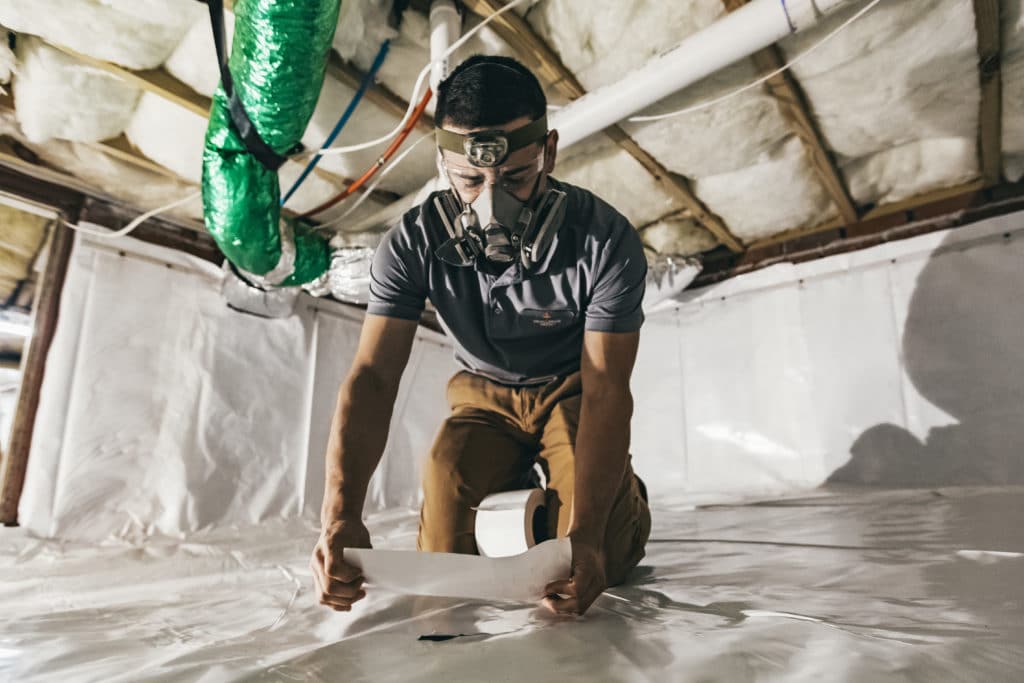What is a crawl space and what’s its purpose?
Does your home have a basement or a crawl space? Many people confuse the two if they have an unfinished area under their homes. However, crawl spaces really are different than basements and have their own set of unique problems. Identifying whether you have a crawl space is quite easy as they have several common characteristics that make them different from basements. So, let’s go over the question “What is a crawl space?”
Crawl Space (noun)

Crawl Space Characteristics
Crawl spaces are alternatives to basements that create a barrier between the ground and the floor of a home. They are usually small, unfinished spaces underneath a home ranging from one to three feet in height, although sometimes crawl spaces have areas high enough for homeowners to stand up. Generally, you have to crawl in and out of them, thus the name. Crawl spaces are elevated foundations that use footings and block walls to support a building. This unfinished space provides additional room for plumbing, electrical wiring and HVAC equipment, although some crawl spaces can be empty. A crawl space always vents to the exterior instead of venting to the interior as basements do.
Why Homes Have Crawl Spaces
We’ll go beyond just answering what is a crawl space. We’ll also discover the reasoning for them. The most common reason to have a crawl space is that the home is located in a damp area, which is why crawl spaces are common in the southeastern United States. However, they are also common in other areas of the country when a home is located near bogs or marshland. The support off the ground that a crawl space provides can protect your home from excessive moisture that could build up and damage basement walls.
Another reason for having a crawl space as part of your home’s foundation is cost. Crawl spaces are cheaper than digging out a full basement as they aren’t as deep. Builders need to move less dirt than for a basement. Neither do they need to ensure that a grade is level to create a concrete slab; thus, construction costs are less.
Common Crawl Space Problems
As homes age, crawl spaces tend to develop problems. Although traditional crawl spaces have vents leading to the outside, homeowners sometimes modify ventilation due to moisture, which is the most common problem associated with crawl spaces. Other frequent problems include mold and mildew, pests, floor failure, wood rot and structural foundation damage, plumbing problems and electrical issues. Crawls space problems can lead to other issues inside the home that include odors, increased heating and cooling bills, and poor indoor air quality that can lead to severe allergies and other respiratory issues.
Essential Crawl Space Maintenance
Although your crawl space is out of sight and therefore out of mind, you should perform regular maintenance on the area. Inspect and clean the area twice a year, just before winter and summer, to look for problems and rid the area of dust and debris that will attract pests. Use a flashlight to look for signs of mold, mildew, water and foundation cracks that require structural repairs. Dirty, unmaintained crawl spaces can also cause problems with HVAC, electrical and plumbing systems that are located there. Rotted beams in a crawl space can jeopardize your home’s structural integrity. When you find problems, contact the proper professionals to remedy the situation.

Resolving Moisture Issues
For homeowners with significant moisture issues, performing maintenance to minimize or eliminate them is of utmost importance. If your home has poor ventilation, you are more likely to experience moisture issues in the crawl space. Without regular evaluation, you may suddenly realize you have issues that have turned into significant problems, such as foundation cracks and wood rot. Excess dirt also leads to excess moisture.
Vapor Barriers
Installing a vapor barrier is one of the best ways to solve a crawl space moisture problem. Essentially, these are large sheets of plastic that fully cover exposed dirty. While they don’t eliminate moisture completely, they slow the process significantly and can be an easy DIY project for homeowners if you’re willing to get dirty and do the work.
Encapsulation
If vapor barriers don’t work, encapsulating the crawl space is the next step in moisture remediation. This process involves using a vapor barrier with sealing tape along with French drain tiles, a sump pit and pump, insulation and a dehumidifier to remove moisture from the air. To properly perform encapsulation, have an experienced professional handle the work. Encapsulation changes your crawl space from a ventilated area to a conditioned area.
Resolving Energy Loss
Even though the crawl space is not in a livable part of your home, this space can often contribute to energy loss. If you find your HVAC is on all the time in winter and summer, your crawl space may require insulation to allow you to save money on energy bills. How and where to place insulation depends on your particular circumstances. For some crawl spaces, placing insulation in the area between the floor joists is sufficient. For homes in subfreezing climates, insulating the walls and sealing the crawl space is more energy-efficient.
Crawl Space Pest Control
Sometimes, no matter how frequently you clean our crawl space, pest likes insects and rodents will find their way in to make permanent homes. Pests like termites, spiders, carpenter ants, rats and mice can damage insulation and vapor barriers, dig into wood and even invade the main part of your home. Pest infestations can also cause allergy problems. Proper sealing of all entrances and exits, along with extermination efforts, can ensure proper pest control of your home’s crawl space. Partnering with an extermination service can reduce or eliminate pest problems.
Additional Solutions to Crawl Space Issues
Not all solutions to crawl space problems need to take place within the crawl space itself. As your home ages, the soil around it shifts and settles, thereby causing crawl space problems, especially those involving moisture. To minimize moisture in your crawl space, consider regrading the immediate area around your home to direct moisture away from the foundation. Make sure that gutters and downspouts are in good repair, add downspout extensions to move water further away from your home and install French drains to help water descend at a location that is lower than your crawl space.

